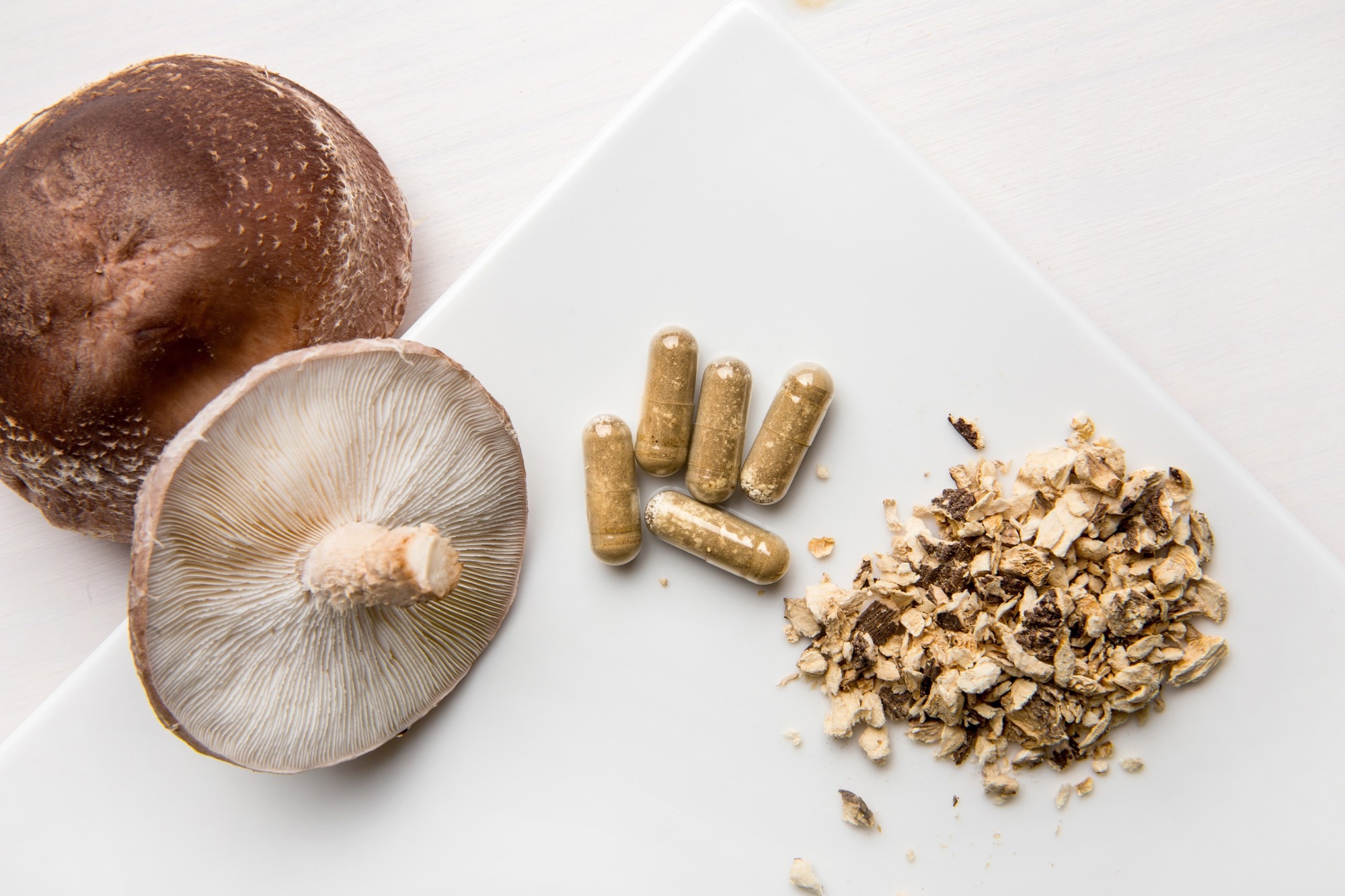Hell, hasn't your doctor years ago had the dietician create a diet protocol on mushrooms? NO? Then you don't have a functioning stroke doctor.
magic mushrooms (23 posts to October 2014)
mushrooms (14 posts to October 2014)
Edible mushrooms: the role of antioxidant compounds as potential candidates for neurodegenerative disease prevention and treatment
In a recent review published in the Nutrients Journal, researchers reviewed existing data on edible mushrooms as dietary sources of antioxidants for preventing neurodegenerative diseases (NDs) associated with aging.
 Study: Antioxidant Compounds from Edible Mushrooms as Potential Candidates for Treating Age-Related Neurodegenerative Diseases. Image Credit: FotoHelin/Shutterstock.com
Study: Antioxidant Compounds from Edible Mushrooms as Potential Candidates for Treating Age-Related Neurodegenerative Diseases. Image Credit: FotoHelin/Shutterstock.com
Background
Edible mushrooms reportedly produce different antioxidant compounds such as polysaccharides, flavonoids, phenolics, ergothioneine, carotenoids, and vitamins.
Therefore, mushrooms may be used as dietary supplements to improve antioxidant defenses and prevent age-associated NDs, characterized by increased oxidative stress, especially among older adults.
About the study
In the present study, researchers presented the role of oxidative stress in age-associated NDs and the potential of edible mushrooms to preserve healthy aging.
Role of oxidative stress in health, aging, and neurodegenerative diseases
In healthy conditions, reactive oxygen species (ROS)/RNS are balanced by efficient defense mechanisms. However, the oxidant levels increase during aging, while the antioxidant defenses become less efficient, generating an imbalance that leads to oxidative stress.
The condition results in oxidative damage to the main biomolecules, leading to the development of age-related neurodegenerative conditions such as Alzheimer’s and Parkinson’s diseases.
The hallmarks of aging include cellular senescence, telomere shortening, genomic instability, epigenetic alterations, loss of proteostasis, deregulated nutrient sensing, stem cell exhaustion, and altered intracellular communication.
An increase in oxidative stress with advancing age could result in mitochondrial dysfunction, lipid peroxidation, lipid membrane alterations, protein oxidation, deoxyribonucleic acid (DNA) and messenger ribonucleic acid (mRNA) damage, chronic inflammation, and cell death.
As a consequence, NDs may develop, with increased Aβ and α-synuclein protein deposition, neuroinflammation, and neuronal dysfunction.
Antioxidant mycochemicals of edible and medicinal mushrooms
Antioxidants obtained from edible mushrooms include flavonoids, phenolics, vitamins (α, β, γ, δ-tocopherol and tocoretinol, and ascorbic acid), carotenoids (α- and β-carotene, and β-cryptoxanthin), polysaccharides (pleuran, lentinan, and β-glucan), and ergothioneine. Which prevent damage by free radicals, including peroxynitrite (ONOO-), O2-, nitric oxide (NO), and hydroxyl (OH).
Mushrooms also provide minerals such as potassium (K), phosphorus (P), magnesium (Mg), sodium (Na), calcium (Ca), zinc (Zn), manganese (Mn), iron (Fe), copper (Cu), cobalt (Co), nickel (Ni), selenium (Se), and glutathione (GSH).
The antioxidants increase longevity, improve overall health, and reduce cell death and inflammation to prevent the development of age-associated NDs. Agaricus bisporus fungi contain acid-retrievable polysaccharides (AcAPS) that have prevented hydroxyl- and diphenyl-1-picrylhydrazyl (DPPH)-induced damage in vitro and conferred nephric and hepatic protection by enhancing serological enzymatic activity in aged mice, in vivo.
Endo-polysaccharides (EnPS) and exopolysaccharides (ExPS) have been obtained from Agaricus brasiliensis, with similar properties in vitro, in addition to an improvement in total antioxidant capacity (TAC) with lowered malondialdehyde (MDA) content.
Agrocybe aegerita contains alkalic-retrievable and acid-retrievable mycelia polysaccharides (Al-MPS and Ac-MPS) that can scavenge DPPH and hydroxyl activities, increase superoxide dismutase (SOD), catalase (CAT), glutathione peroxidase (GPx), and TAC, decrease MDA content, and reduce lipid peroxidation.
Agrocybe aegerita intake has reduced serological triglyceride and cholesterol levels in aged mice. Agrocybe cylindracea, comprising the SL-02 selenium polysaccharide and exopolysaccharides (EPS), has demonstrated similar properties.
Sulfated polysaccharides (SFPS) in Flammulina velutipes can scavenge DPPH, hydroxyl, and superoxide radicals, chelate iron, lower lipid peroxidation, and improve anti-inflammatory responses.
Ganoderma lucidum comprises polysaccharides that lower amyloid toxicity, neurotoxicity, MDA content, microglial activation, interleukin-1 beta (IL-1β), and tumor necrosis factor-alpha (TNF-α) levels.
In addition, the antioxidants increase GSH and GPx activity to prevent dopaminergic neuronal inflammation. Grifola frondose comprises polysaccharides (GFP), including intracellular-type Zn polysaccharides (IZPS). Hericium erinaceus comprises sulfated residue polysaccharide (SHRP) compounds that scavenge free radicals and lower MDA content.
The antioxidants in Lentinula edodes (MPS with and without zinc), Lepista sordida (CLSP polysaccharides), and Pholiota nameko (Zn-rich MZPS polysaccharides) have demonstrated similar properties.
Pleurotus eryngii comprises polysaccharides (PEP) and enzymatic residue polysaccharides (PERP) that have shown neuroprotective activity, preventing β-amyloid-inflicted neurotoxicity among rats, improving the functioning of the liver, skin, and brain, in vivo.
Similarly, consuming Pleurotus ostreatus, comprising polysaccharides (POP), and Pleurotus sajor-caju, comprising the PSP2-1 polysaccharide, improved cognition in rats with Alzheimer’s disease, reducing MDA and acetylcholinesterase (AchE) activity.
Polysaccharide TFPS, in Tremella fuciformis, improves hydrogen peroxide-caused oxidative-type stress and inhibits apoptosis among human cutaneous fibroblasts through sirtuin 1 (SIRT1) upregulation.
Increased CAT and SOD activity has been observed in aged murine animals that consumed Tricholoma lobayense, comprising TLH-3 polysaccharide.
Conclusions
Based on the review findings, edible and medicinal mushrooms are safe and non-toxic foods that comprise various antioxidants that can prevent neurodegeneration among aged individuals, particularly ergothioneine and polysaccharides. Vitamins and phenolics may act synergistically to counteract oxidative damage and preserve brain health.
Additionally, most human studies used whole mushrooms, powders, or extracts and did not assess the health-promoting effects of isolated compounds.
However, studies involving humans to evaluate the neuroprotective effects of mushrooms are limited, warranting further research to assess mushroom-induced neuroprotection, elucidate the underlying molecular neuroprotective mechanisms, and define optimal intake levels.
-
Liuzzi, G. et al. (2023) "Antioxidant Compounds from Edible Mushrooms as Potential Candidates for Treating Age-Related Neurodegenerative Diseases", Nutrients, 15(8), p. 1913. doi: 10.3390/nu15081913. https://www.mdpi.com/2072-6643/15/8/1913


No comments:
Post a Comment